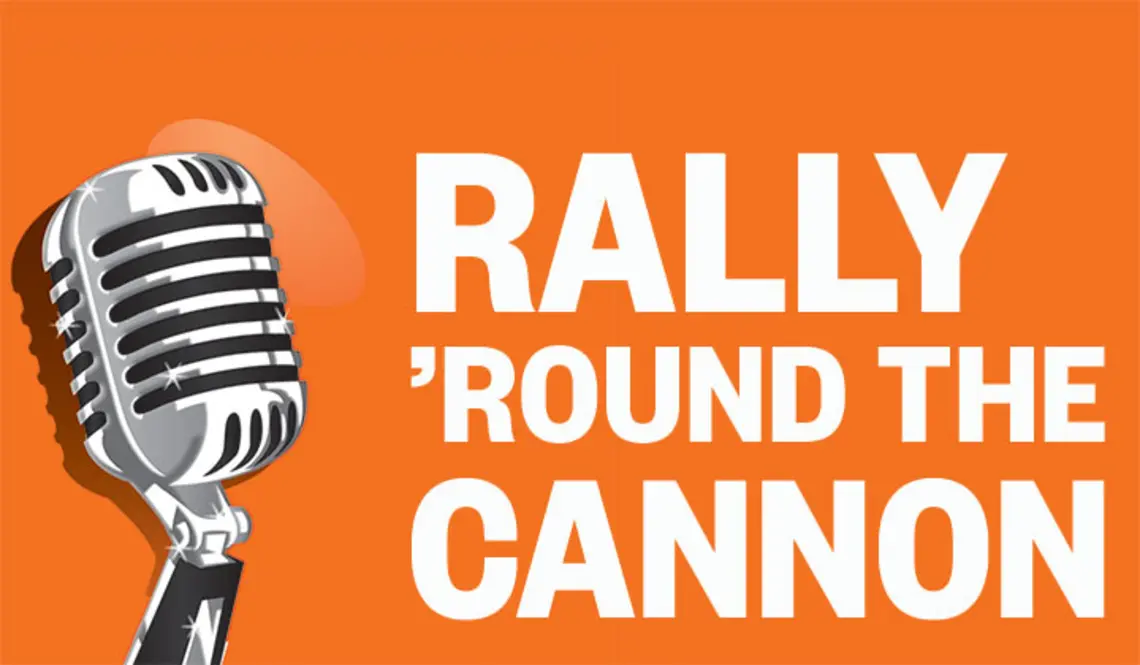
In this episode, Gregg talks about his favorite claustrophobically mesmerizing staircase, Princeton’s prowess in physics and astrophysics, and his column about Jewish life on campus in the 1920s and ’30s.
The Rally ’Round the Cannon podcast is also available on iTunes — click here to subscribe
TRANSCRIPT
BT: I’m Brett Tomlinson, the digital editor of the Princeton Alumni Weekly.
GL: And I’m Gregg Lange from the great Class of 1970, who should know better.
BT: And this is the Rally ’Round the Cannon podcast, a podcast about Princeton history and the people behind it. At the end of our last episode, Gregg asked a trivia question to which we did not get any responses. The question came back indirectly in the print issue. If you go to page 13 On the Campus opener of the issue, we have this wonderful photo of the spiral staircase that leads to the top of the Graduate College’s tower. And that tower has what distinction, Gregg?
GL: Well, it is the national memorial to Grover Cleveland, funded by the nickels and dimes from schoolchildren all over the U.S. in honor of the former president, who was there for its dedication in 1913 and then died soon thereafter. For that reason, it is called Cleveland Tower, and as we noted last time around Grover Cleveland was buried in Princeton Cemetery along with Vice-President Aaron Burr, Jr., and his father and grandfather, who served as Princeton’s presidents. I also wanted to make a special note of Ricardo Barros’ photo because that stairway is the dankest, tightest, and [possibly] most disconcerting place you will have encountered in your entire life, and to have made it look semi-habitable is next to miraculous.
BT: Well, you’ve just anticipated my next question, as I wanted to ask if you’ve made that climb before, and apparently you have.
GL: I absolutely have, I’ve done it twice actually. The last time was during the Centennial celebration of the Graduate College back in 2013. And if I had remembered from the first time how claustrophobically mesmerizing it was, I would have probably run the other way. Going up to the first gallery, underneath the carillon, which is one of the great carillons in the Western Hemisphere by the way, is not too bad. But going above that, it actually narrows even more, and it is really awful. As a not-delicate person, who is a little bit claustrophobic anyways, it was not my cup of tea. But it’s a magnificent photograph.
BT: Flipping one page of the print edition, we get to some big news on the Princeton Plasma Physics Lab (PPPL), as it’s known. Before we get into the modern story, I’m sure you can fill us in on the history of that lab and how it came to be located at Princeton. I believe you’ve written a bit about it before.
GL: In conjunction with a couple of other things, including the great John Archibald Wheeler, probably one of the great minds of the 20th century, who taught at Princeton for many, many decades. He retired once, came back 10 years later, hung around, worked with probably around four different generations of physics students, and was absolutely worshipped by all of them among a great number of many other people. He was Richard Feynman’s mentor at Princeton. Feynman spent a large portion of his Nobel Prize lecture detailing how Wheeler had spent very, very extensive periods of patient time with Feynman, correcting all of the assumptions and approaches that he took in that work that eventually won Feynman a Nobel Prize. Thus, making it clear that he regarded Wheeler as the greatest physicist of the 20th century, which, of course, included such lightweights as Einstein, with whom Wheeler worked, I might add with, along with other Princetonians including Feynman and Eugene Wigner on the Manhattan Project during World War II. There’s another good TV series that you have to look to find on WGN America called Manhattan, which is very fascinating if not an overly darkened version of Los Alamos.
Anyway, Wheeler came out of WWII and the research on the atomic bomb and was then instrumental in the setup for the research relating to the hydrogen bomb. His entire reason for being fascinated by that, along with the astrophysicist Lyman Spitzer, who was fairly young at that point in his late 30s, was the potential of fusion power for peaceful energy. Of course, it’s been a huge attraction ever since it was theorized, about the same time that the fusion bomb was activated by the U.S. and shortly after that by the Soviet Union in the early ’50s. But this was a very peaceful application of it, and one of the great things about a fusion reactor is not only does it have no residual, dirty mess to clean up after you’re done creating the energy, but that if anything goes wrong with it, but as opposed to what you’ve seen with nuclear reactors of other types, the most recent catastrophe being in Japan. As opposed to that, if something goes wrong with the fusion reactor, it stops and that’s it. As a matter of fact, it’s so benign conceptually that all American work on fusion power reactors has been declassified since 1958. So, one reason that Princeton runs the PPPL is that, unlike many other cutting-edge scientific technologies, there is absolutely nothing about it that’s classified. The University as a matter of policy refuses to manage classified research projects, although its faculty is free to work on them on their own. As a result, the University is free to run the PPPL and has made some wonderful discoveries and advances over the years, but it’s always a political football, the funding comes and goes.
Lyman Spitzer, who eventually became the chair of the astrophysics department for many, many years, was also in the forefront of all kinds of ideas, in terms of interstellar issues, space, and how it was composed. Along with such folks from the physics Department, as David Wilkinson, after whom WMAP was named, became explorers of the far-reaches of the universe. In the same edition that you’re looking at, a little further on, we have Jeremy Kasdin and David Spergel, two Princeton professors who were undergrads there, and they’re working on a new satellite called WFIRST, which is going to be out there that is looking for two different kinds of things as a space telescopic platform: one is distant planets, to see if there are any “Goldilocks planets” out there; and the other is investigating dark energy.
And what I thought I’d mention very briefly is what is probably my favorite Princeton physics story of all time, which comes from Alumni Day. I believe it was 2002. At any rate, it was right after the first photos of cosmic background radiation in color – the big oval maps you’ve seen of various colors – came back from WMAP. There was a big presentation on it at Alumni Day and one of the young astrophysics professors was describing all of this stuff and what it implied about the universe and all of the rest of this, and was giving effusive praise, posthumously at that point, to David Wilkinson, who had died maybe 18 months earlier, from the physics department and talking about what her colleagues in the astrophysics department were doing.
At the end of this session, where she had totally overwhelmed all of the alumni, she asked for questions and there were a couple of interesting ones, from scientists in the audience. And then she called on somebody in the back of the room, who stood up and said, “Could you explain to me, given all that we’ve talked about today and the interactions, why are there separate physics and astrophysics departments?”
She seemed sort of taken aback, since that really wasn’t her problem. The questioner was [former Princeton president] Bob Goheen ’40 *48. And he was entirely serious. The whole room, and essentially every alumnus in the room recognized him, broke into uproarious laughter, and there was a standing ovation for both of them. That’s a magnificent alumni-centric story.
BT: That leads into my next topic. Speaking of alumni gatherings, there’s a conference coming up April 14-16, and it’s a gathering celebrating 100 years of Jewish life on campus. You’ve written about it rather extensively in your current column and in another one coming up, but I was wondering if you could speak briefly about the conference and what you think this means for Princeton, reflecting on the history of Jewish life on campus.
GL: Well, of course for starters, it’s not any kind of secret that through a large chunk of the 20th century, Princeton not only discriminated against racial minorities on campus, in terms of admissions and in other areas, but additionally against Jewish students as well. And it’s a very different story. While you assume that it has to do with closed-minded WASPs in both cases, which has some truth to it, there are different things going on, and I thought it was worth talking about. This issue’s column online focuses on the early days of all of this, and actually differentiates some of what was going on at the turn of the 20th century.
The other story that the column this week tells is that of the Morgenthau family. Henry Morgenthau Sr., who was a first-generation immigrant, became the U.S. ambassador to the Ottoman Empire during the early days of World War I before the United States got involved – a critical [diplomatic] position – after having been a contributor to Woodrow Wilson. Then additionally his son, Henry Morgenthau Jr., who was a critical and close friend of Franklin Delano Roosevelt and who became the secretary of the treasury at probably the most stressful time for the treasury in the history of the United States, 1934, and stayed in that job until the end of World War II – so certainly one of the most critical cabinet officers in the history of the United States. His son, Henry Morgenthau III, was a Princeton undergraduate in the class of 1939, Freddie Fox’s class; he was both an athlete, a cross country runner, and an editorial-board member of the Princetonian, worked on Theatre Intime, and was completely frozen out of bicker in 1937, obviously because he was Jewish, along with four of the other 11 Jewish students in the class.
And the question I pose is how do you get from the point of Albert Einstein being awarded an honorary doctorate and being the toast of Princeton in 1921 to Henry Morgenthau, the son of the secretary of the treasury of the United States, being hosed in bicker 16 years later?
BT: Gregg, I think we’ve reached the end of our time for this episode. I would just add that if you have a topic you’d like to hear about, please email us at paw@princeton.edu.
GL: And always recall to your personal betterment that Rally ’Round the Cannon is a podcast from the Princeton Alumni Weekly online.
Paw in print

January 2026
Giving big with Kwanza Jones ’93 and José E. Feliciano ’94; Elizabeth Tsurkov freed; small town wonderers.


No responses yet